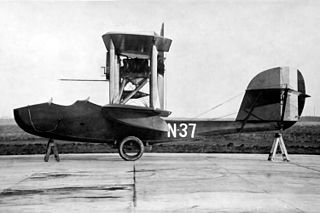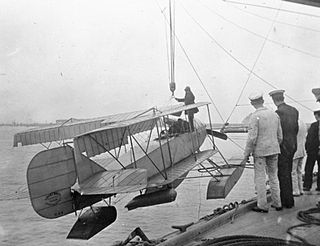
The Sopwith Pup is a British single-seater biplane fighter aircraft built by the Sopwith Aviation Company. It entered service with the Royal Naval Air Service and the Royal Flying Corps in the autumn of 1916. With pleasant flying characteristics and good manoeuvrability, the aircraft proved very successful. The Pup was eventually outclassed by newer German fighters, but it was not completely replaced on the Western Front until the end of 1917. Remaining Pups were relegated to Home Defence and training units. The Pup's docile flying characteristics also made it ideal for use in aircraft carrier deck landing and takeoff experiments and training.

The Sopwith T.1 Cuckoo was a British biplane torpedo bomber used by the Royal Naval Air Service (RNAS), and its successor organization, the Royal Air Force (RAF). The T.1 was the first landplane specifically designed for carrier operations, but it was completed too late for service in the First World War. After the Armistice, the T.1 was named the Cuckoo.

The Sopwith 1+1⁄2 Strutter was a British single- or two-seat multi-role biplane aircraft of the First World War. It was the first British two-seat tractor fighter and the first British aircraft to enter service with a synchronised machine gun. It was given the name 1+1⁄2 Strutter because of the long and short cabane struts that supported the top wing. The type was operated by both British air services and was in widespread but lacklustre service with the French Aéronautique Militaire.

The Sopwith Tabloid and Sopwith Schneider (floatplane) were British biplanes, originally designed as sports aircraft and later adapted for military use. They were among the first successful types to be built by the Sopwith Aviation Company. The "Tabloid", so named because of its small size, caused a sensation when it made its first public appearance.

The Armstrong Whitworth F.K.10 was a British two-seat quadruplane fighter aircraft built by Armstrong Whitworth during the First World War. While it was ordered in small numbers for the Royal Flying Corps and Royal Naval Air Service, it was not used operationally. It is one of the few quadruplane aircraft to reach production.
The Sopwith Admiralty Type 807 was a 1910s British biplane seaplane designed and built for the Admiralty by the Sopwith Aviation Company.

The Sopwith Admiralty Type 860 was a 1910s British biplane seaplane torpedo bomber designed and built for the Admiralty by the Sopwith Aviation Company.
The Port Victoria P.V.7 Grain Kitten was a prototype British Fighter aircraft of the First World War designed and built by the Port Victoria Marine Experimental Aircraft Depot on the Isle of Grain. A very small and light biplane intended to fly off platforms on Royal Navy Destroyers, it was unsuccessful, only a single prototype being built.

The Port Victoria P.V.8 Eastchurch Kitten was a prototype British fighter aircraft of the First World War designed and built by the Port Victoria Marine Experimental Aircraft Depot on the Isle of Grain. It was a small and light biplane with a conventional wheeled undercarriage intended to operate from platforms on small ships, but while it had good handling, an unreliable and underpowered engine meant that the aircraft did not enter production, with only one prototype being completed.
The Sopwith B.1 was an experimental British bomber aircraft of the First World War. A single-seat, single-engined biplane, the B.1 was built by the Sopwith Aviation Company for the Royal Navy. Although only two were built, one was used for bombing raids over France.
The Short N.2B was a prototype British patrol seaplane of the First World War, designed and built by Short Brothers. A single-engined biplane intended to replace Short's successful Type 184, only two were built, the Fairey III being preferred.

The Norman Thompson N.1B was a prototype British flying boat fighter aircraft of the First World War. A two-seat single-engined pusher biplane, a single example was built in 1917, but no production followed.
The Sopwith Three-seater was a British aircraft designed and built prior to the start of the First World War. One of the first aircraft built by the Sopwith Aviation Company, it was operated by both the Royal Naval Air Service (RNAS) and the Royal Flying Corps (RFC), being used briefly over Belgium by the RNAS following the start of the War.

The Curtiss C-1 Canada was a twin-engined bomber aircraft of the First World War which was designed by Curtiss of America to be built by their Canadian subsidiary for the British Royal Naval Air Service and Royal Flying Corps. Although large orders were placed, only twelve were built, the type being rejected in favour of more capable aircraft such as the Handley Page O/100.
The Port Victoria P.V.9 was a British single-seat biplane floatplane fighter of the First World War. Although claimed to be the best aircraft of its type yet to be tested, only a single prototype was built.
The Sopwith Cobham was a British twin-engined triplane bomber aircraft designed and built by the Sopwith Aviation Company during the First World War. The only twin-engined aircraft built by Sopwith, the Cobham did not fly until after the end of the war, and was unsuccessful due to the failure of its engines, only three prototypes being built.

The Short Admiralty Type 81 was a series of British two-seat floatplanes built prior to the First World War, and used by the Royal Naval Air Service in the early years of the war. They were powered by 160 hp (120 kW) Gnome Lambda-Lambda 14 cylinder two-row rotary engines and had folding wings to aid storage on ship, hence the popular name Short Folder, shared with a number of other seaplanes made by Short Brothers.

The Sopwith 2B2 Rhino was a British two-seat triplane bomber designed and built by Sopwith Aviation Company as a private venture. The Rhino was powered by a 230 hp (172 kW) Beardmore Halford Pullinger inline piston engine. Only two aircraft were built and the type did not enter production.
The Port Victoria P.V.5 was a British single-engined floatplane fighter aircraft of the First World War. A single example was built and flown at the Royal Naval Air Service's Port Victoria Marine Experimental Aircraft Depot on the Isle of Grain in 1917. Despite demonstrating good manoeuvrability and handling, no production followed, with the Royal Naval Air Service instead using landplanes for the fighter role.
The Sunbeam Bomber was a prototype single-engined, single seat bomber aircraft of the First World War. Only one example flew as the type proved to be unsuccessful and was abandoned.











